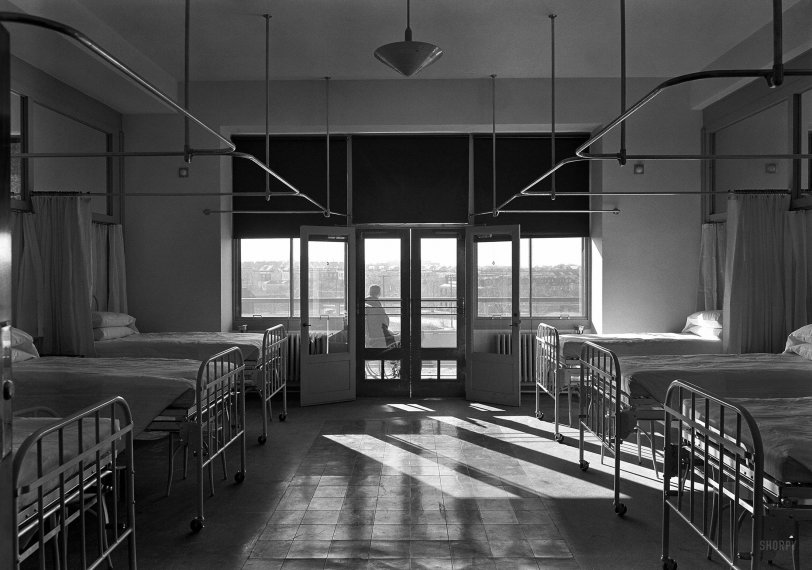


Framed or unframed, desk size to sofa size, printed by us in Arizona and Alabama since 2007. Explore now.
Shorpy is funded by you. Patreon contributors get an ad-free experience.
Learn more.

- Baldwin 62303
- Baldwin VO-1000
- Cold
- No expense spared
- Tough Guys
- Lost in Toyland
- And without gloves
- If I were a blindfolded time traveler
- Smoke Consumer Also Cooks
- Oh that stove!
- Possibly still there?
- What?!?
- $100 Reward
- Freeze Frame
- Texas Flyer wanted
- Just a Year Too Soon
- WWII -- Replacing men with women at the railroad crossing.
- Yes, Icing
- You kids drive me nuts!
- NOT An Easy Job
- I wonder
- Just add window boxes
- Icing Platform?
- Indiana Harbor Belt abides
- Freezing haze
- Corrections (for those who care)
- C&NW at Nelson
- Fallen Flags
- A dangerous job made worse
- Water Stop
Print Emporium
Triboro TB: 1940

December 23, 1940. "Triboro Hospital for Tuberculosis. Parsons Boulevard, Jamaica, Queens. Typical six-bed ward, to balcony. Eggers & Higgins, architect." Large-format negative by Gottscho-Schleisner. View full size.
Depressing place
TB wards are very depressing structures, more so when one considers that until the late 1960s, we didn't have a real way to treat TB. Meaning that when someone went to a place like this, it wasn't to be cured or get better. It was to simply die.
[Effective treatments, including cures, for TB date to the development of antibiotics in the 1940s, not 1960s. Most TB infections are asymptomatic; for active cases requiring hospitalization before the antibiotic era, mortality was around 50 percent. - Dave]
What makes it worse is the practices of the day for dealing with the deceased. Once a person passed away from the illness, every possession in their room which they came in contact with was incinerated. This was done because at the time they did not know how the illness was transmitted. What makes it worse, is that in most every TB hospital, there was also a crematorium. So the bodies were also burned. Once again, it is due to the fact that they didn't know how the illness was transmitted.
Large TB wards, like Waverly, had their own crematoriums on site; with several retorts to handle the sheer number of deaths. Others would contract it out to funeral homes or in some cases press the hospital's own incinerator into use.
You - Outside the Door!
Move to the middle, you're throwing off the symmetry!
Ship Shape
I had always heard this hospital started life as a Naval Hospital, as in a forerunner of the VA system, and that's why it's shaped like a battleship. SS Tuberculosis?
Floor Tiles
Wow, for a brand new hospital I can't believe how those floor tiles make it look like it's been there for a hundred years already!
Matron would never approve
Matron would never approve of those lumpy-bumpy beds. All beds must be made to within an inch of their lives, preferably with straight edges and flat surfaces that would put a set of mathematical instruments to shame.
Even in this day and age of lax standards, beds must be made with precision and care, and even I have sent care staff back into rooms to remake beds that fail to meet standards of either cleanliness or visual appeal. Of course, in these times the alternating pressure air mattresses in wide use make the snappy hospital corners a difficult thing to achieve, but it still can be done.
Now-vacating T-Building
This building is currently known as the "T-Building" of the former Queens Medical Center, now part of the Queens Hospital Center. The lengthy balconies, running most of the length of its southern side on seven levels, and rounded ends, give it distinctive character. QHC board minutes show that the few remaining operations there are being relocated. According to a January 2013 story in the Queens Times-Ledger, a proposal is pending to convert it into a residential facility for low-income patients with chronic illnesses. There is, as they say, neighborhood opposition. See article here.
Brand new
The hospital opened in 1940, so it's brand new in this picture. Quite possibly this ward had yet to admit its first patient. Somewhat surprisingly, given NYC's penchant for closing hospitals left and right (Brooklyn's Long Island College Hospital got the ax just the other day), Triboro Hospital is still there, though of course it's no longer a tuberculosis facility. It's now a currently-vacant part of Queens Hospital Center.
NYC's biggest tuberculosis hospital by far, in fact it was the biggest in the world, was Seaview Hospital on Staten Island. Built over a period of about 25 years starting shortly before World War I, at its peak it housed thousands of patients in more than twenty buildings. It even had the world's only maternity ward in a tuberculosis hospital (how's that for a cheery thought?)
Seaview was shut down in the early 1960's, though some of the newer buildings were converted into a still-extant rehabilitation facility. Several of the old buildings still remain in extremely decrepit condition, in fact they are so decrepit as to deter all but the most intrepid and/or foolhardy urban explorers. Here's a photo and video gallery from a recent exploration:
http://nyulocal.com/city/2012/02/24/exploring-staten-islands-abandoned-s...
























On Shorpy:
Today’s Top 5